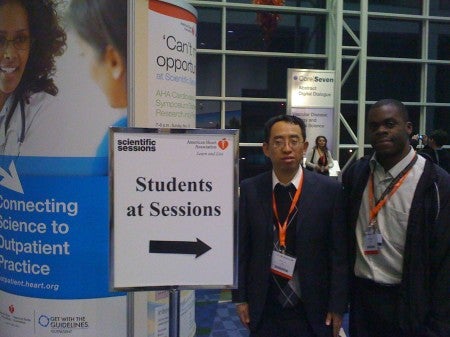“Kingsley and Jixiang did an excellent job with their presentations,” said their advisor, Dr. Steven Ebert, associate professor and Ph.D. program coordinator for the Burnett school. “At a lot of conferences, anyone who submits presentations is accepted. The American Heart Association is much more competitive. Only about 20 percent of the people who submit research actually get to present. So this is a huge accomplishment.”
Kingsley presented a poster on his research into adrenal hormones in the heart. Scientists previously thought all such hormones came from the adrenal glands. But Kingsley’s research has shown that the heart actually makes its own adrenaline, principally in the left side of the heart. Elevated adrenaline hormones have been linked to Tako-Tsubo Syndrome, an overstimulation of the heart when a person is under emotional stress. “Our research suggests that it may be the heart itself that is producing the extra adrenaline, not just the adrenal gland,” said Kingsley, adding that such findings could help in the development of drugs to treat the condition.
Jixiang gave a formal presentation on engineering stem cells with the same enzyme that makes fireflies glow so that scientists can track whether and where the stem cells are working. Stem cells have great potential in treating disease because they can morph into the organs where they are transplanted. Jixiang has developed a process that makes the cells turn green or red as they change, so that scientists can better tract their growth. He also has engineered the stem cells with antibiotics to make them purer for the patient.
Both doctoral students said they received positive reactions to their research from American Heart Association conference attendees.
“We came back from Chicago even more excited about our research,” said Kingsley.
